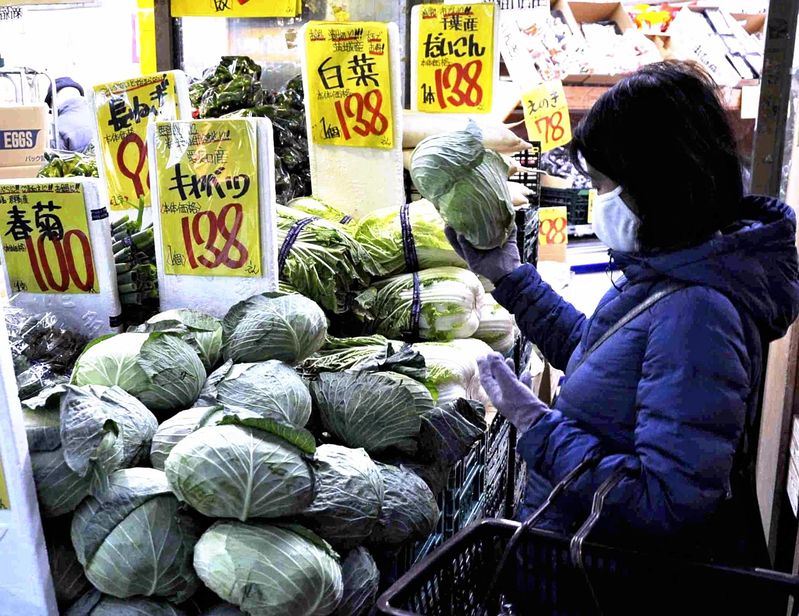
A woman examines a cabbage that costs ¥138 at the Shinjuku Yaoya shop in Shinjuku Ward, Tokyo, on Thursday. The Yomiuri Shimbun
TOKYO — Vegetable prices have dropped significantly, making consumers happy but vexing farmers and retailers.
The price falls are attributable to favorable weather conditions leading to good harvests and a slump in the restaurant industry amid the novel coronavirus pandemic.
At the beginning of December, lettuce was selling for ¥58 (P27) per head and Chinese cabbage was going for ¥138 (P64) a head at Shinjuku Yaoya fruit and vegetable shop in Shinjuku Ward, Tokyo. Both prices are more than 40% lower than normal rates.
“The vegetables I buy on a daily basis have gotten cheaper,” a homemaker in her 60s said. “It helps.”
However, vegetable sales are sluggish. Due to the spread of the coronavirus, sales to restaurants and other businesses, which account for 10% to 20% of total sales, have stagnated while households have become more frugal.
“No matter how much we discount them, vegetables aren’t selling well,” said Hidetoshi Aramaki, senior managing director of Shinjuku Yaoya’s operator.
Leafy greens, in particular, do not last long. Stores are forced to sell them at a discount all at once if there is excessive stock. On Wednesday, Shinjuku Yaoya even gave away about 500 heads of lettuce for free.
The wholesale median price of lettuce fell 61% during the Nov. 20-26 period compared with the same time frame a year ago, according to Ota Market in Tokyo. Prices have fallen across the board, with a 58% decrease for Chinese cabbage, 35% for cabbage and 16% for daikon radishes.
According to an Agriculture, Forestry and Fisheries Ministry analysis, the price falls have been brought about by oversupply as no typhoons made landfall for the first time in 12 years and the food services sector has been hit by declining demand.
Vegetable-producing areas have been plagued by the price falls.
“If prices get any lower, we can’t make a profit,” said an official of JA Hainan in Makinohara, Shizuoka Prefecture, an area of lettuce production. “There’s the risk that some farmers will stop farming if prices continue to drop.”
Meat prices on the rise
On the other hand, prices for domestically produced chicken and pork are likely to remain high. According to the agriculture ministry, the wholesale price of chicken thigh was ¥654 (P302) per kilogram in Tokyo in November, about 12% higher than in the same month last year. The wholesale pork price was 16% higher at ¥531 (P245).
Poultry is a relatively differentiated item, with domestic products for home use and imports for business use. Decreased demand from the food services sector is unlikely to push down the price of domestic meat products.
In addition, poultry is usually frozen in summertime when demand drops, in order to stock up for use in the winter. This year, however, poultry sales for home use have been upbeat even in the summer as more consumers did their own cooking amid the pandemic. Already low inventories are believed to be a factor in prices remaining high, according to a meat wholesaler.
Japan is also experiencing a spike in cases of highly pathogenic avian influenza. The impact of the bird flu is limited for now, but there are concerns that prices could rise further if shipments are delayed.